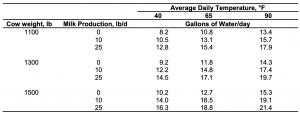“How Much Water Do Those Cows Need?”
By: Justin Waggoner, Ph.D., Beef Systems Specialist
Most cattle producers fully understand the importance of water. After all, providing an adequate supply of clean, fresh water is the cornerstone of animal husbandry and there are very few things that compare to the feeling of finding thirsty cows grouped around a dry tank. Water is important and, in situations where the water supply is limited or water is being hauled (i.e. grazing crop residues), one of the first questions we find ourselves asking is “how much water do those cows need”? The old rule of thumb is that cattle should consume 1-2 gallons of water per 100 lbs of bodyweight. Water consumption increases linearly as ambient temperature increases above 40° Fahrenheit such that cows require an additional gallon of water for every 10 degree increase in temperature. Additionally, lactation also directly increases the amount of water required by beef cows. The table below summarizes the daily water requirements of beef cows of several different body weights, milk production levels and ambient temperatures (Adapted from Spencer, 2016).
Spencer, C., Lalman D. Rolf, M., Richards, C. 2016, Estimating water requirements for beef cows. Kansas State University MF3303. https://www.bookstore.ksre.ksu.edu/pubs/MF3303.pdf
For more information, contact Justin Waggoner at jwaggon@ksu.edu.


 The first weeks of June often bring summer-like temperatures to the southern Great Plains and with those first hot, humid days comes heat stress. Recent market conditions have created a scenario when there are greater inventories of heavier cattle on feed in many feedyards. The convergence of these two factors prompted our KSU Beef Extension Team to host a webinar highlighting the current weather outlook and how to prepare for heat stress events. The webinar was recorded and may be accessed
The first weeks of June often bring summer-like temperatures to the southern Great Plains and with those first hot, humid days comes heat stress. Recent market conditions have created a scenario when there are greater inventories of heavier cattle on feed in many feedyards. The convergence of these two factors prompted our KSU Beef Extension Team to host a webinar highlighting the current weather outlook and how to prepare for heat stress events. The webinar was recorded and may be accessed